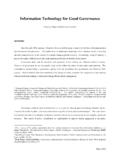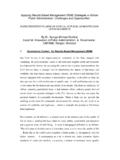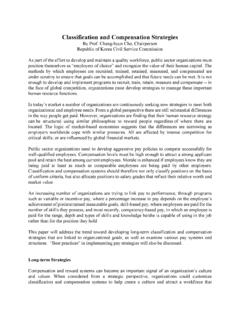Transcription of Evaluation of the Effectiveness of the Tax Collection ...
1 Evaluation OF THE Effectiveness OF THE TAX. Collection - THE CASE OF THE CZECH CENTRAL AND. LOCAL GOVERNMENTS1. Leos V tek, Karel Pubal Faculty of Management, University of Economics Prague, Czech Republic Introduction The measurement of the administrative cost associated with tax system is a part of theory and policy of taxation and enables us to see a public finance from the angle of positive economy and makes the decision concerning taxation policy at central even local level less difficult to economist. Theoretically the measurement of the administrative costs is not too difficult main issue lays at perfect determination of particular type of taxation costs and its proper measurement. The Evaluation of tax efficiency collecting in the Czech Republic is suffering from lack of support data. The data are available on an aggregate level, but for measurement of administrative costs and analysis of costs for particular taxes are inapplicable.
2 Present structure of the tax revenue in the Czech Republic The fundamental legal rule determining the following list of the taxes that may be collected in the territory of the Czech Republic is the Act approved by the Federal Assembly of the former Czech and Slovak Federal Republic: indirect taxes value added tax selective consumption excise taxes tax on hydrocarbon fuel and lubricants tax on spirit and spirits tax on wine tax on beer tax on tobacco products customs direct taxes 1. Grant Agency of the Czech Republic supported this research. 1. income taxes individual income tax corporate income tax (legal entity income tax). health insurance contributions social security contributions property taxes real estate tax land tax tax on constructions road tax inheritance tax gift tax real estate-transfer tax local taxes environmental taxes (special Act was not passed so far). In addition to the upper described structure there are also collected the health insurance contributions and the social insurance contributions specified by special Acts.
3 Municipalities at the present time may collect local taxes from these objects: dogs accommodation capacity, spa capacity, recreation capacity municipal free space admission price playing slot machines For these local taxes the Czech law use synonyms local fees. Local (and central). governments also collect administrative fees. Not being taxes these fees are not analysed in this paper. From the point of view of the fiscal federalism the health insurance contributions are not revenues assigned to the even central nor local government budget but they go to the extra budgetary public funds. The social security contributions are revenue of the central budget. Allocation of the tax revenue between central and local governments is shown in the following table: Allocation of the tax revenue between central and local governments since 2000. REVENUE OF THE CENTRAL REVENUE OF LOCAL GOVERMENTS REVENUE OF REGIONAL. GOVERMENT (INCLUDING CENTRAL GOVERMENTS.)
4 FUNDS). VAT (except revenues allocated to local Real estate tax 3,1% of the total VAT revenue and regional governments) 20,59% of the total VAT revenue 3,1% of the total personal 2. PIT (except revenues allocated to local 20,59% of the total personal income tax (PIT) income tax (PIT) revenue from and regional governments) revenue from employees employees CIT (except revenues allocated to local 20,59% of the withholding PIT revenue 3,1% of the withholding PIT. and regional governments) 20,59% of the total corporate income tax revenue Social insurance contributions (CIT) revenue 3,1% of the total corporate Health insurance contributions (revenue 20,59%*0,6 of the total advances for PIT income tax (CIT) revenue of the health insurance companies) 30% of the PIT revenue from self-employed 3,1%*0,6 of the total advances Road tax (revenue of the Fund of incomes for PIT. transport infrastructure). Excise taxes (20% revenue of the tax on hydrocarbon fuel and lubricants goes to the Fund of transport infrastructure).
5 Inheritance tax Gift tax Real estate-transfer tax Source: Act 243/2000 Sb. Tax Reform in The Czech Republic in 1993. The basic Acts creating the tax law in the Czech Republic came into force on the same day on which an independent Czech Republic was established, on the 1st of January 1993. The new tax law represents one of the basic components of the transition of the Czech economy. By accepting this new tax system the tax reform culminated although it was actually launched as early as in the year 1990 by the gradual adaptation of the budget revenues system which definitely was not compatible with the multi-sector economy, with the private undertakings and with the gradual privatisation of the economy. Until the "Velvet Revolution" in November 1989 the system of budgetary revenues was mainly based on the transfers of state enterprises to national budget, but centrally planned investments were (to a considerable part) covered by budgetary subsidies.
6 The income taxes were combined with payroll taxes. For nongovernmental organizations the common income taxes were replaced WITH special income taxes with a rather complicated structure. The taxes paid by citizens formed only a complementary part of revenue of the government budget. The most important of them was a tax on salaries the structure of which was different from the standard individual income tax. Its progression finished far below the level of the average salary and for this reason the average tax rate was, in view of the taxpayer's age and the number of dependents, dependent on the social position of the taxpayer rather than on the level of his income. Salaries were taxed separately which resulted in the fact that several parallel smaller incomes were taxed less than one income equal to the sum of the smaller incomes. The tax payments were the responsibility of the employer. 3. Different kinds of incomes were subjected to further taxes but their total revenue was very low.
7 Very confusing was also indirect taxation represented, above all, by turnover tax which had thousands of different tax rates and which should have ensured the separate existence of wholesale and retail prices rather than any budgetary revenue. The tariff of the turnover tax rates was, even with a reduction in the number of rates that had been carried out since the sixties, a pretty thick book. The tax was collected in a lump sum only on the prices of consumer goods and was further complicated by the existence of the so-called negative turnover tax which was a form of a subsidy on selected products such as basic foodstuffs, energy for households, and, for many years, also on the clothing and footwear for children, etc.). The tax reform was divided into three consecutive stages. In the first stage the reform concentrated on basically "cosmetic" alterations in the existing system of budgetary revenues in order to better meet the changing conditions in the economy and the year besides these changes, it should have promoted the then emerging private undertakings.
8 At the beginning of the year 1991, the turnover tax rates were unified by the introduction of three basic rates. The second stage was actually the preparation for the new tax system. When developing this tax, several principal goals were set for the new tax system (Kubatova, 2000): Improvement the level of tax fairness, expressed by the same approach to all taxpayers regardless their legal status and the source of the incomes of individuals. Increase in the proportion of consumer tax (while simultaneously decreasing the proportion of products with higher consumer taxation). The consumer taxation instrument was value added tax in divided conception, common in the countries of the European Union. Increase in the significance of individual income taxation, while simultaneously unifying the taxation of the overwhelming majority of taxable incomes, as well as unifying (and gradually decreasing) the legal entity income taxation.
9 This process should result in a significant decrease in the legal entity income taxation. Creation of space for the utilization of the fiscal system as an instrument for macroeconomic regulation. Preparation for the integration of our tax system with the tax systems of European countries and for our joining the European Union in the future. 4. Division of the insurance system into general health insurance and social security insurance and a contribution to the government employment policy so that individuals realize their responsibility for their social security and their rate of effort to ensure this security. Introducing a newly outlined tax system in the year 1993 launched the third stage of the tax reform. It is necessary to note that the new system was not represented only by new names and conceptions of taxes, but also by brand new tax administration. It was necessary to train thousands of new financial and tax clerks in many tax offices and to ensure their material and technical equipment.
10 Effectiveness of the tax Collection administrative costs of taxation The basic reason of interest about administrative cost of taxation can be considered etc.: - Fiscal reason in case of administrative costs - Effort about complexity decision about Effectiveness of public spending (should not be taking into account only narrow direct costs on project, but even cost associated with taxation. The idea of tax Effectiveness has several meanings very often. At the first the Effectiveness can be consider as ability of government to collect taxes with low costs. These costs administrative cost of tax system (AC) is a sum of all government level costs jointed with tax system. We can assume that the criteria of Effectiveness of taxation is total burden (ET), which is a sum of all administrative costs (AC), compliance costs (SCC) and dead weight loss (DWL). There are several techniques that can be used for data Collection . Vaillancourt (1987) in the following table (for compliance cost data Collection ) shows that each method has advantages and disadvantages.)










